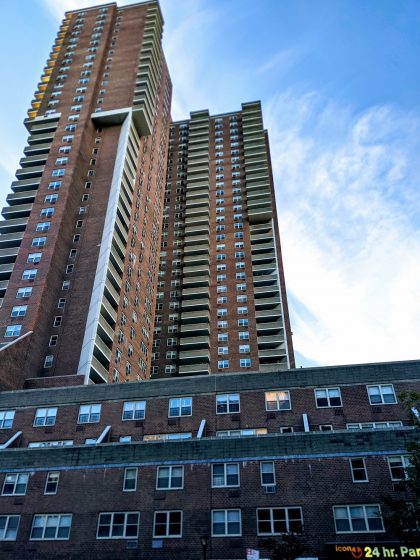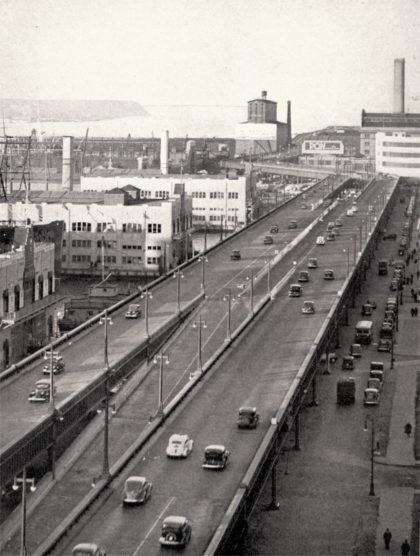Categories
Left column house ads
Designer of Independence Plaza dies at 82
January 19, 2021 History, People
Charlie Komanoff flagged this obit in The Times for Barry Goldsmith, who designed Independence Plaza, completed in 1975. And it is thoroughly worth a read both because of the imprint he made on the neighborhood and for his own personal story — starting with his escape from the Nazis in the arms of his father in 1942.
But he also worked on Westway — the failed plan to bury the West Side Highway in landfill from the Battery to 42nd Street — and so it’s safe to say he had a hand in two of the biggest development projects in Tribeca, even if one was never realized.
When the three towers of IPN were built, they replaced four blocks of warehouses and low-rise buildings, with cobblestone streets in between. From The Times: “The gargantuan complex embodied all the contradictions of postwar urban architecture. Complete with shopping and office space, Mr. Goldsmith’s towers were a city within a city, subsidized to keep middle-class New Yorkers from fleeing for the suburbs. But their construction required the demolition of several dozen acres of New York history, and their fortress-like street front turned a back on the city they were intended to help save.”
Goldsmith left before the project was finished, hired away by Skidmore, Owings & Merrill to work on Westway. By then, a portion of the elevated highway in the Village had collapsed and elected officials were angling to build an interstate highway with mostly federal dollars, burying six lanes in landfill and putting a park and commercial and residential real estate on top.
Westsiders fought that plan over years and years, succeeding eventually, and the result in a way was Hudson River Park (which some of them also fought, but that’s another story) and the current Route 9A, or West Street, or West Side Highway, built as a boulevard rather than an interstate.
It’s worth noting that the idea of building on landfill has come back again with the city’s “Financial District and Seaport Climate Resilience Master Plan” and the plans to wipe out and rebuild East River Park and will no doubt meet the same resistance.
10 Comments
Comment:
Subscribe
Subscribe to the TC Newsletter















It’s a shame he succeeded with Independence Plaza and failed with the Westway. The end result is two eyesores that disrupt access to the waterfront and feel entirely out of character from the rest of the neighborhood. The Hudson River Parkway is a lovely effort to turn an uninviting highway into an inviting parkspace, but it’s insane to think that we could have buried the highway, opened it up to park space, and had the federal government foot 90% of the bill. What were people in the early 1980s thinking in opposing it?!
How dare you call IPN an eyesore. The residents of IPN inhabited this neighborhood when nobody else wanted to live down here. The residents fought for a supermarket, as there was nothing down here, as well as other amenities that you take for granted. Now that we have the entitled living here complaining about access to the waterfront. What’s stopping you from walking to the river Sir?
Hear, hear! I used to deliver groceries to IPN in the 70’s from the West Village. Best tips of the day and the nicest, most gracious people. We were bringing water to the desert. There was NOTHING in Tribeca then. And never would have been without IPN. I wound up moving there in 2000 and loved it for about 15 years; then the new condos and yoga and spinning studios took over. $27 for a burger at Bubby’s? Come on. That’s a hip and cool neighborhood? That’s the Upper East Side. Murray Hill.
I’d like to add something that I posted on these pages a few years ago when I had the opportunity to observe the Independence Plaza buildings from an elevated level a few blocks north. I saw that these were well-proportioned, highly functional modernist designs that were really quite exciting, especially in the context of the time they were built. They exuded optimism and a feeling of monumentality that could have anchored a neighborhood of completely different complexion, and whose history might have taken a very different course, possibly for the better in terms of the vitality of the city. Those buildings are worthy of higher praise, imo.
@Scott; as an Independence Plaza Pioneer (1979-1980) I can assure you these buildings did nothing to disrupt access to the waterfront. At the time they were built, there was no meaningful reason to walk along what were essentially piles of rubble disintegrating into the still-polluted Hudson. There was no Chelsea Piers, no cruise-y walking, biking, or tanning scene to speak of. If we wanted Hudson River-side space, we could walk south to the landfill that was to become Battery Park City, or north to the Meatpacking District which at the time was 90% involved in packing actual meat (unless one ventured into the Trucks, which is for another post). As @LongTimeFirstTime states, there was absolutely not a morsel to be eaten nor an amenity to be had, and the IP was a godsend to a 22-year-old aspiring writer and my 21-year-old aspiring graphic artist roommate. My days at IP are now dream-like, but if you knew where to look, you could stand on the cinderblock balcony and see down to rising young star Robert DeNiro’s loft on an adjacent block.
@Scott — since you asked. Westway was basically a taxpayer-financed swindle disguised as a park that would have *worsened* traffic and pollution by making it easier for more cars and trucks to be driven into and through Manhattan and onto narrow city streets. (Look up “induced demand.”) Not only did the opponents see this, they promoted the idea of “trading in” Westway funds for mass transit –an option they helped write into federal highway legislation that helped rejuvenate public transportation in New York and other U.S. cities. If you’re curious, there’s more in this eulogy I wrote a year ago to one of the leaders of the opposition, Carolyn Konheim: https://nyc.streetsblog.org/2019/12/02/in-memoriam-do-all-the-good-you-can-the-life-of-urban-ecology-pioneer-carolyn-konheim/
I also believe Westway would have been taken over with development – much as West Street is now. Can you imagine the number of buildings on top of that highway right up to the water’s edge 20 years ago. We were not the “enlightened” citizens we are now. The West Street alternative, while at times feeling like the River Jordan, is a much better solution. The Park is one of the best in the country.
I’ve been a long time resident of IPN. Maybe the longest. One’s eyesore is another’s contented legacy. I suppose I should leave it at that.
urban renewal is an improvement over the rundown obsolete
Washington Market buildings and streetscape. missing are
the local landmarks like the Market Diner and the workers burning
trash in steel drums.
R.I.P. Barry Goldsmith. IPN is a tributary to the decent human being I always strive to be.